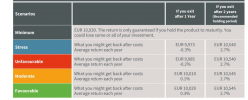Dan_The_Man
Registered User
- Messages
- 58
Any considerations with this one?
Term: 2 years
Capital Protection: 100%
Capital Protection Goldman Sachs Group Inc
Provider: (Moody’s: A2/S&P: BBB+/Fitch: A)
Fixed Return: 2.7% paid out at the end of each year regardless
to investment performance
Underlying Index: EuroStoxx 50 Index (SX5E Index)
Potential Return Additional return of 0.05% if EuroStoxx 50 Index is
at Maturity: at or above its initial level
Summary Risk
Indicator: 2
Minimum Return: 5.4%
Maximum Return: 5.45%
Minimum Amount: €100,000
Closing Date: 30 August 2023 (or earlier if fully subscribed)
Liquidity: Daily, via stock market listing
Taxation: Income Tax for Personal Investors
Availability: Personal: Conexim and Omnium Investment
Platforms
Pension: Self Administered and Self Directed
Insured Plans
Term: 2 years
Capital Protection: 100%
Capital Protection Goldman Sachs Group Inc
Provider: (Moody’s: A2/S&P: BBB+/Fitch: A)
Fixed Return: 2.7% paid out at the end of each year regardless
to investment performance
Underlying Index: EuroStoxx 50 Index (SX5E Index)
Potential Return Additional return of 0.05% if EuroStoxx 50 Index is
at Maturity: at or above its initial level
Summary Risk
Indicator: 2
Minimum Return: 5.4%
Maximum Return: 5.45%
Minimum Amount: €100,000
Closing Date: 30 August 2023 (or earlier if fully subscribed)
Liquidity: Daily, via stock market listing
Taxation: Income Tax for Personal Investors
Availability: Personal: Conexim and Omnium Investment
Platforms
Pension: Self Administered and Self Directed
Insured Plans
